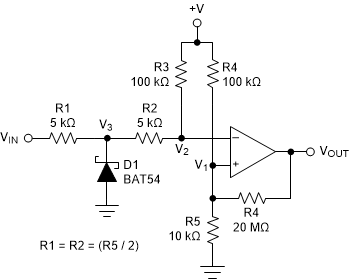SNOSDC9C October 2022 – December 2024 TLV1811-Q1 , TLV1812-Q1 , TLV1814-Q1 , TLV1821-Q1 , TLV1822-Q1 , TLV1824-Q1
PRODMIX
- 1
- 1 Features
- 2 Applications
- 3 Description
- 4 Pin Configuration and Functions
- 5 Specifications
- 6 Typical Characteristics
- 7 Detailed Description
-
8 Application and Implementation
- 8.1 Application Information
- 8.2 Typical Applications
- 8.3 Power Supply Recommendations
- 8.4 Layout
- 9 Device and Documentation Support
- 10Revision History
- 11Mechanical, Packaging, and Orderable Information
Package Options
Mechanical Data (Package|Pins)
Thermal pad, mechanical data (Package|Pins)
Orderable Information
8.2.8 Zero Crossing Detector
 Figure 8-17 Zero Crossing Detector
Figure 8-17 Zero Crossing DetectorA voltage divider of R4 and R5 establishes a reference voltage V1 at the non-inverting input. By making the series resistance of R1 and R2 equal to R5, the comparator output switches when VIN = 0V. Diode D1 clamps V3 near ground. The voltage divider of R2 and R3 then prevents V2 from going below ground. A small amount of hysteresis is setup to maintain rapid output voltage transitions.